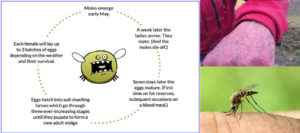Midges – Questions and Answers
What are midges?
A midge is a small two-winged fly that forms swarms and breeds near water or marshy areas.
Where are they found?
The Highland Midge prefers to lay its eggs in slightly acidic habitats, typically peaty soils containing favourite plants like rushes. When they’re not biting they like to hide in long bracken, or among moss on tree bark. This type of habitat dominates western areas of Scotland.
Midges are found (seasonally or otherwise) on practically every land area outside permanently arid deserts and the frigid zones.
What do they look like?
Midges are tiny flying insects with a wingspan of only 2-3mm. There are over 35 different species of biting midge in Scotland, but it is Culicoides impunctatus, otherwise known as the Highland Midge that earns its place as Scotland’s most ferocious foe.

Why do midges bite?
It is only the female midge that bites. They emerge with enough fat reserves to mature their first batch of eggs, but need a blood meal to give subsequent batches enough nutrients to grow. Meanwhile, the boys suck on plant nectar and in this species are no trouble at all.
How do they find you?
Midges can smell human breath. They have receptors on their antennae that detect the carbon dioxide released when we exhale. Those plumes of CO2 rise into the air, acting as trails that the midges follow to find the source. Our skin produces more than 340 chemical odors, and some of them smell like dinner to midges.
Midges can detect the warmth of your body – actually, the blood inside it – then land on you and locate the best capillaries for tapping.
Pregnant midges if they find you, will let off a pheromone invitation for friends to join her. Hence the swarm…
When do midges bite?
You’ll hear people in Scotland talking about ‘Midgey weather’. Midges thrive on still, humid conditions. They aren’t big fans of a breeze. With only 2mm of wing to flap they go nowhere fast when the wind speed is above 7mph. Light intensity signals feeding time. The Highland Midge is most active in low-light conditions i.e dawn and dusk, or when cloud cover significantly reduces the intensity of the sunlight.
Is a midge bite sore?
Midges tend to feed for about 3-4 minutes and you’re unlikely to feel a thing. Until afterwards. If you are bitten, the best thing to relieve midge bites is anti-histamine cream. If you can bear it, try not to scratch.
Are some people more susceptible?
Yes. Some people are more attractive to midges (combination of body odour, temperature etc.) and some people react badly to bites. Midges pump an anti-coagulant into the wound they create to feed from, our immune systems respond to this anticoagulant creating the itching and swelling. Our immune responses are different, which accounts for the variance seen throughout the population.
How can I stop myself from getting bitten?
Midge bites can be painful, itch intensely and in some instances swell up alarmingly.
If you’re travelling to a midge hotspot, use proven insect repellents and cover up at dawn and dusk.
Protective gear, such as hats, head nets and midge jackets can be very effective too, especially if you know you are heading into a midge magnet area such as the Scottish wetlands during midge season.
If you are doing any physically exerting activity outdoors such as hill walking, try to wear insect repellent clothing for added protection, as sweat and body heat can attract a swarm of midges.
Camping out? make sure you have a midge net to protect you at all costs. Your sanity may be at stake.


